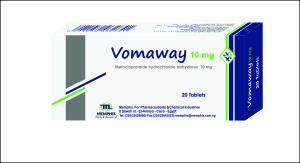1.Name Of The Medicinal Product: VOMAWAY TABLETS 2.Qualitative And Quantitative Composition: Active ingredient: Metoclopramide hydrochloride monohydrate 10.50 mg (equivalent to metoclopramide HCl anhydrous 10 mg) For the full list of excipients, see section 6.1 3.Pharmaceutical Form: White to ivory white round flat tablet plain from one side and scored from the other side with beveled edges. 4.Clinical Particulars 4.1 Therapeutic indications Adult population VOMAWAY is indicated in adults for: - Prevention of delayed chemotherapy induced nausea and vomiting (CINV) - Prevention of radiotherapy induced nausea and vomiting (RINV). - Symptomatic treatment of nausea and vomiting, including acute migraine induced nausea and vomiting. VOMAWAY can be used in combination with oral analgesics to improve the absorption of analgesics in acute migraine. Paediatric population VOMAWAY is indicated in children (aged 15 -18 years) for: - Prevention of delayed chemotherapy induced nausea and vomiting (CINV) as a second line option. 4.2 Posology and method of administration Posology Adult population The recommended single dose is 10 mg, repeated up to three times daily. The maximum recommended daily dose is 30 mg or 0.5mg/kg body weight. The maximum recommended treatment duration is 5 days. Paediatric patients aged 15-18 years Prevention of delayed chemotherapy induced nausea and vomiting (CINV) The recommended dose is 0.1 to 0.15 mg/kg body weight, repeated up to three times daily by oral route. The maximum dose in 24 hours is 0.5 mg/kg body weight. Dosing table Age Body Weight Dose Frequency 15-18 years Over 60kg 10 mg Up to 3 times daily The maximum treatment duration is 5 days for prevention of delayed chemotherapy induced nausea and vomiting (CINV). Tablets are not suitable for use in children weighing less than 61 kg. Other pharmaceutical forms/strengths may be more appropriate for administration to this population. Method of administration: A minimal interval of 6 hours between two administrations is to be respected, even in case of vomiting or rejection of the dose (see section 4.4). Special population Elderly In elderly patients a dose reduction should be considered, based on renal and hepatic function and overall frailty. Renal impairment: In patients with end stage renal disease (Creatinine clearance ≤ 15 ml/min), the daily dose should be reduced by 75%. In patients with moderate to severe renal impairment (Creatinine clearance 15-60 ml/min), the dose should be reduced by 50% (see section 5.2). Hepatic impairment: In patients with severe hepatic impairment, the dose should be reduced by 50% (see section 5.2). Paediatric population VOMAWAY is contraindicated in children aged less than 1 year (see section 4.3). 4.3 Contraindications • Hypersensitivity to the active substance or any of the excipients listed in 6.1. • Gastrointestinal haemorrhage, mechanical obstruction or gastrointestinal perforation for which the stimulation of gastrointestinal motility constitutes a risk. • Confirmed or suspected phaeochromocytoma due to the risk of severe hypertension episode. • History of neuroleptic or Metoclopramide-induced tardive dyskinesia. • Epilepsy (increased crises frequency and intensity) • Parkinson's disease • Combination with levodopa or dopaminergic agonists (see section 4.5). • Known history of methaemoglobinaemia with Metoclopramide or of NADH cytochrome-b5 deficiency. • Use in children less than 1 year of age due to an increased risk of extrapyramidal disorders (see section 4.4) Metoclopramide should not be used during the first three to four days following operations such as pyloroplasty or gut anastomosis as vigorous muscular contractions may not help healing.
